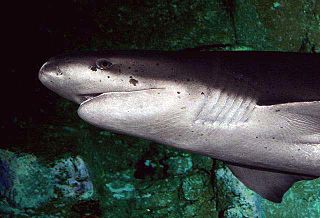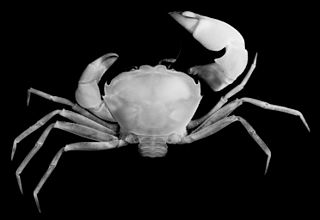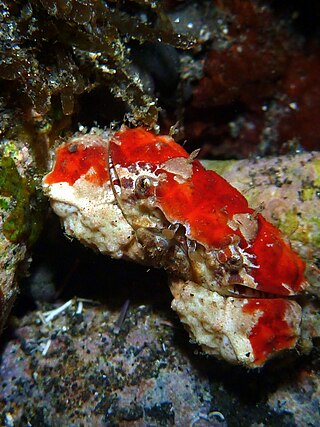
Carcharhiniformes, the ground sharks, are the largest order of sharks, with over 270 species. They include a number of common types, such as catsharks, swellsharks, and the sandbar shark.

The Hexanchiformes are a primitive order of sharks, that numbering just seven extant species in two families. Fossil sharks that were apparently very similar to modern sevengill species are known from Jurassic specimens.

Xanthidae is a family of crabs known as gorilla crabs, mud crabs, pebble crabs or rubble crabs. Xanthid crabs are often brightly coloured and are highly poisonous, containing toxins which are not destroyed by cooking and for which no antidote is known. The toxins are similar to the tetrodotoxin and saxitoxin produced by puffer fish, and may be produced by bacteria in the genus Vibrio living in symbiosis with the crabs, mostly V. alginolyticus and V. parahaemolyticus.
Luis Guinot Jr. was an American diplomat who was the U.S. Ambassador to Costa Rica from 1991 to 1993.

The Bythograeidae are a small family of blind crabs which live around hydrothermal vents. The family contains 16 species in six genera. Their relationships to other crabs are unclear. They are believed to eat bacteria and other vent organisms. Bythograeidae are a monophyletic, sister taxon of the superfamily Xanthoidea which split to inhabit hydrothermal vents around the Eocene.

Dromiidae is a family of crabs, often referred to as sponge crabs. They are small or medium-sized crabs which get their name from the ability to shape a living sponge into a portable shelter for themselves. A sponge crab cuts out a fragment from a sponge and trims it to its own shape using its claws. The last two pairs of legs are shorter than other legs and bend upward over the crab's carapace, to hold the sponge in place. The sponge grows along with the crab, providing a consistent shelter.
Etyiidae is a prehistoric family of dromiacean crabs only known from Cretaceous and a few Paleocene fossils.
Mioceratodus is an extinct genus of lungfish in the family Neoceratodontidae, which also contains the extant Queensland lungfish. It is known only from Oligocene and Miocene-aged sediments in Australia, although phylogenetic evidence supports it having first diverged from its closest relative, Neoceratodus, during the Late Jurassic or Early Cretaceous period.
Maria Guinot was a Portuguese singer, best known for her participation in the 1984 Eurovision Song Contest.

Hexapodidae is a family of crabs, the only family in the superfamily Hexapodoidea. It has traditionally been treated as a subfamily of the family Goneplacidae, and was originally described as a subfamily of Pinnotheridae. Its members can be distinguished from all other true crabs by the reduction of the thorax, such that only seven sternites are exposed, and only four pairs of pereiopods are present. Not counting the enlarged pair of claws, this leaves only six walking legs, from which the type genus Hexapus, and therefore the whole family, takes its name. Some anomuran "crabs", such as porcelain crabs and king crabs also have only four visible pairs of legs. With the exception of Stevea williamsi, from Mexico, all the extant members are found either in the Indo-Pacific oceans, or around the coast of Africa.

Corystidae is a family of crabs, in its own superfamily, Corystoidea. It includes what was once thought to be the oldest Eubrachyuran fossil, Hebertides jurassica, thought to be dating from the Bathonian ; the species was subsequently reinterpreted as being Cenozoic in age. Corystidae contains ten extant and five extinct species in eight genera:

Goneplacoidea is a superfamily of crabs containing 11 extant families, and two families known only from fossils.
Dakoticancroidea is a superfamily of fossil crabs, containing six species in five genera, divided into two families. The family Dakoticancridae is only known from North American rocks of Late Cretaceous age, while the single species in the Ibericancridae was found in Spain.

Pseudozioidea is a superfamily of crabs, formerly treated in the Eriphioidea, Carpilioidea, Xanthoidea, Pilumnoidea and Goneplacoidea. A number of fossils from the Eocene onwards are known from the family Pseudoziidae. Eleven genera are recognised in three families:

The family Homolidae, known as carrier crabs or porter crabs, contains 14 genera of marine crabs. They mostly live on the continental slope and continental shelf, and are rarely encountered. Members of the Homolidae have their fifth pereiopods in a sub-dorsal position, which allows them to hold objects in place over the rear half of the carapace. The objects carried include sponges, black corals and gorgonians, and this behaviour may be a defence mechanism against predators. Some species have been observed carrying living sea urchins in a symbiotic relationship which allows them to benefit from the protection of the urchin's dangerous spikes.

Hypocolpus is a genus of crabs in the family Xanthidae, containing the following species:

Garthiope is a genus of crabs in the family Xanthidae, containing the following species:

The Panopeidae are a family containing 26 genera of morphologically similar crabs, often known as "mud crabs". Their centers of diversity are the Atlantic Ocean and eastern Pacific Ocean.
Danièle Guinot is a French biologist, an emeritus professor at the Muséum national d'histoire naturelle in France, known for her research on crabs.

Cancrocaeca xenomorpha is a species of troglobitic (cave-dwelling) freshwater crab from Sulawesi, the only species in the monotypic genus Cancrocaeca. It has been described as the world's "most highly cave-adapted species of crab".













